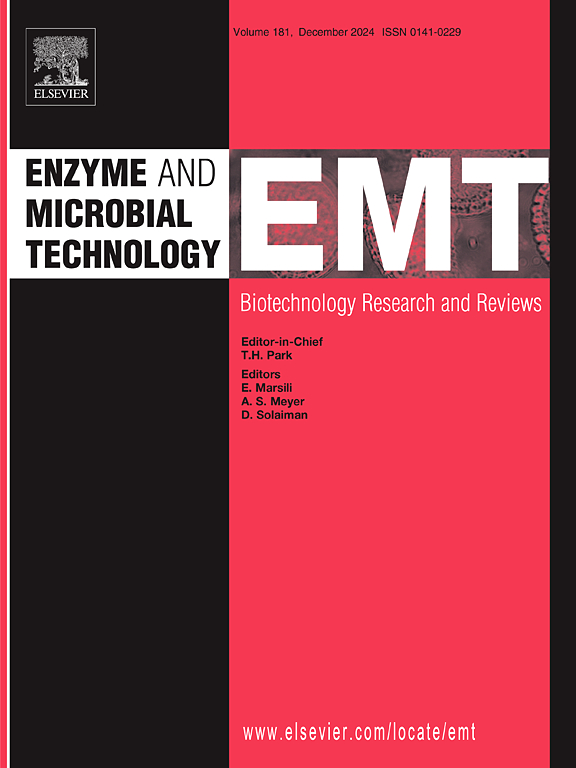真菌蛋氨酸合成酶动力学的优化比色微标法测定钴胺非依赖性蛋氨酸合成酶活性。
IF 3.4
3区 生物学
Q2 BIOTECHNOLOGY & APPLIED MICROBIOLOGY
引用次数: 0
摘要
曲霉(Aspergillus spp.)和根霉(Rhizopus spp.)用于固态植物食品发酵,编码钴胺不依赖蛋氨酸合成酶活性(MetE, EC 2.1.1.14)。在这里,我们研究了来自大豆曲霉、delemar根霉和小孢子根霉这三种不同的食物发酵相关真菌的三种MetE的酶动力学、反应活化能(Ea)、热稳健性和结构折叠,并将它们与来自大肠杆菌的MetE进行了比较。我们还缩小并优化了比色法,以允许在微孔板上直接测量MetE活性。3种真菌MetE酶对甲基供体(6S)-5-甲基-四氢蝶酰- l- glutamate3的催化速率kcat为1.2 ~ 3.3 min-1, KM值为0.8 ~ 6.8 µM。在3种真菌酶中,R. delemar MetE的kcat最低,但KM也最低,因此kcat/KM最高,为~ 1.4 min-1µM-1。大肠杆菌酶的kcat较高,为12 min-1,但KM为6.4 µM,因此kcat/KM为~ 1.9 min-1µM-1。真菌MetE的Ea值为52 ~ 97 kJ mol -1,高于大肠杆菌MetE的38.7 kJ mol -1。预测的MetEs构造褶皱非常相似。真菌MetEs的Tm值在41 ~ 54°C之间,其中A. sojae酶最高(54°C), R. delemar最低(41°C)。在30℃时,3种真菌酶的半衰期差异显著,其中黄豆霉的MetE酶的半衰期最长(600 min, kD=0), delemar酶的半衰期最短(17 min)。了解这些酶的动力学对于理解真菌中蛋氨酸的合成是很重要的,也是促进真菌发酵植物性食品中蛋氨酸合成的第一步。本文章由计算机程序翻译,如有差异,请以英文原文为准。
Analysis of enzyme kinetics of fungal methionine synthases in an optimized colorimetric microscale assay for measuring cobalamin-independent methionine synthase activity
Aspergillus spp. and Rhizopus spp., used in solid-state plant food fermentations, encode cobalamin-independent methionine synthase activity (MetE, EC 2.1.1.14). Here, we examine the enzyme kinetics, reaction activation energies (Ea), thermal robustness, and structural folds of three MetEs from three different food-fermentation relevant fungi, Aspergillus sojae, Rhizopus delemar, and Rhizopus microsporus, and compare them to the MetE from Escherichia coli. We also downscaled and optimized a colorimetric assay to allow direct MetE activity measurements in microplates. The catalytic rates, kcat, of the three fungal MetE enzymes on the methyl donor (6S)-5-methyl-tetrahydropteroyl-L-glutamate3 ranged from 1.2 to 3.3 min−1 and KM values varied from 0.8 to 6.8 µM. The kcat was lowest for the R. delemar MetE, but this enzyme also had the lowest KM thus resulting in the highest kcat/KM of ∼1.4 min−1 µM−1 among the three fungal enzymes. The kcat was higher for the E. coli enzyme, 12 min−1, but KM was 6.4 µM, resulting in kcat/KM of ∼1.9 min−1 µM−1. The Ea values of the fungal MetEs ranged from 52 to 97 kJ mole−1 and were higher than that of the E. coli MetE (38.7 kJ mole −1). The predicted structural folds of the MetEs were very similar. Tm values of the fungal MetEs ranged from 41 to 54 °C, highest for the A. sojae enzyme (54 °C), lowest for the R. delemar (41 °C). At 30 °C, the half-lives of the three fungal enzymes varied significantly, with MetE from A. sojae having the longest (> 600 min, kD=0), and R. delemar the shortest (17 min). Knowledge of the kinetics of these enzymes is important for understanding methionine synthesis in fungi and a first step in promoting methionine synthesis in fungally fermented plant foods.
求助全文
通过发布文献求助,成功后即可免费获取论文全文。
去求助
来源期刊

Enzyme and Microbial Technology
生物-生物工程与应用微生物
CiteScore
7.60
自引率
5.90%
发文量
142
审稿时长
38 days
期刊介绍:
Enzyme and Microbial Technology is an international, peer-reviewed journal publishing original research and reviews, of biotechnological significance and novelty, on basic and applied aspects of the science and technology of processes involving the use of enzymes, micro-organisms, animal cells and plant cells.
We especially encourage submissions on:
Biocatalysis and the use of Directed Evolution in Synthetic Biology and Biotechnology
Biotechnological Production of New Bioactive Molecules, Biomaterials, Biopharmaceuticals, and Biofuels
New Imaging Techniques and Biosensors, especially as applicable to Healthcare and Systems Biology
New Biotechnological Approaches in Genomics, Proteomics and Metabolomics
Metabolic Engineering, Biomolecular Engineering and Nanobiotechnology
Manuscripts which report isolation, purification, immobilization or utilization of organisms or enzymes which are already well-described in the literature are not suitable for publication in EMT, unless their primary purpose is to report significant new findings or approaches which are of broad biotechnological importance. Similarly, manuscripts which report optimization studies on well-established processes are inappropriate. EMT does not accept papers dealing with mathematical modeling unless they report significant, new experimental data.
 求助内容:
求助内容: 应助结果提醒方式:
应助结果提醒方式:


